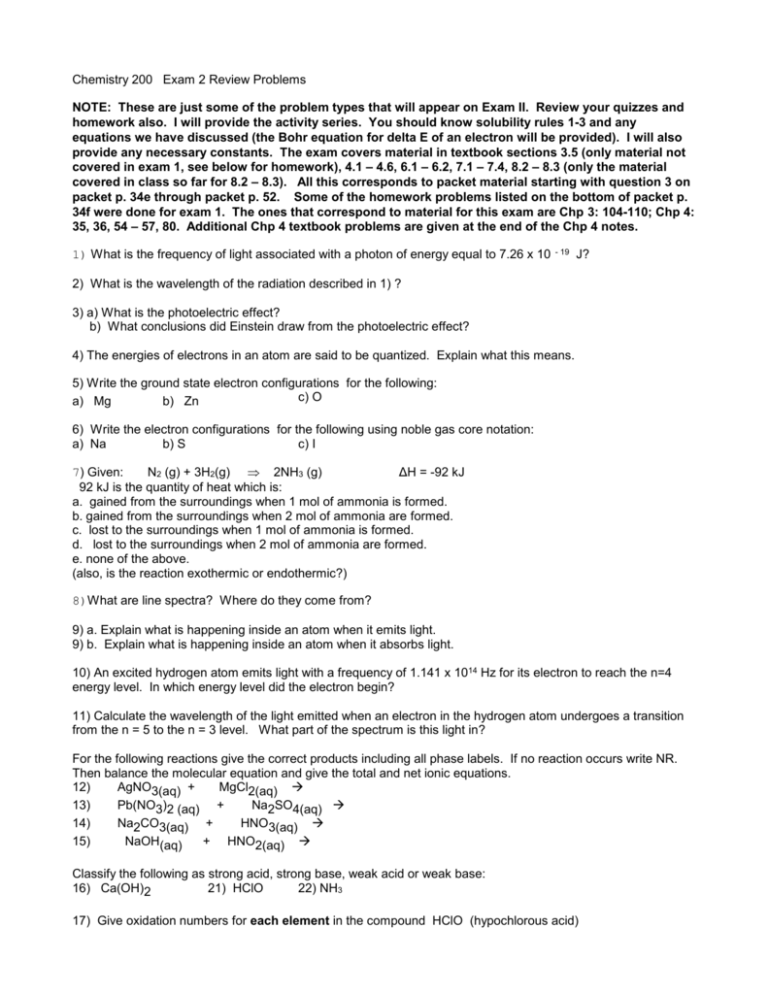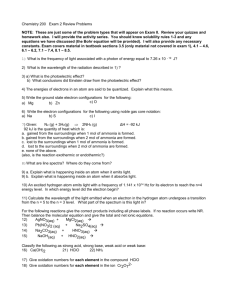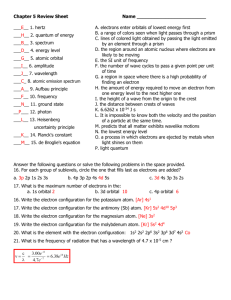E2 Rev
advertisement

Chemistry 200 Exam 2 Review Problems NOTE: These are just some of the problem types that will appear on Exam II. Review your quizzes and homework also. I will provide the activity series. You should know solubility rules 1-3 and any equations we have discussed (the Bohr equation for delta E of an electron will be provided). I will also provide any necessary constants. The exam covers material in textbook sections 3.5 (only material not covered in exam 1, see below for homework), 4.1 – 4.6, 6.1 – 6.2, 7.1 – 7.4, 8.2 – 8.3 (only the material covered in class so far for 8.2 – 8.3). All this corresponds to packet material starting with question 3 on packet p. 34e through packet p. 52. Some of the homework problems listed on the bottom of packet p. 34f were done for exam 1. The ones that correspond to material for this exam are Chp 3: 104-110; Chp 4: 35, 36, 54 – 57, 80. Additional Chp 4 textbook problems are given at the end of the Chp 4 notes. 1) What is the frequency of light associated with a photon of energy equal to 7.26 x 10 - 19 J? 2) What is the wavelength of the radiation described in 1) ? 3) a) What is the photoelectric effect? b) What conclusions did Einstein draw from the photoelectric effect? 4) The energies of electrons in an atom are said to be quantized. Explain what this means. 5) Write the ground state electron configurations for the following: c) O a) Mg b) Zn 6) Write the electron configurations for the following using noble gas core notation: a) Na b) S c) I 7) Given: N2 (g) + 3H2(g) 2NH3 (g) ΔH = -92 kJ 92 kJ is the quantity of heat which is: a. gained from the surroundings when 1 mol of ammonia is formed. b. gained from the surroundings when 2 mol of ammonia are formed. c. lost to the surroundings when 1 mol of ammonia is formed. d. lost to the surroundings when 2 mol of ammonia are formed. e. none of the above. (also, is the reaction exothermic or endothermic?) 8)What are line spectra? Where do they come from? 9) a. Explain what is happening inside an atom when it emits light. 9) b. Explain what is happening inside an atom when it absorbs light. 10) An excited hydrogen atom emits light with a frequency of 1.141 x 1014 Hz for its electron to reach the n=4 energy level. In which energy level did the electron begin? 11) Calculate the wavelength of the light emitted when an electron in the hydrogen atom undergoes a transition from the n = 5 to the n = 3 level. What part of the spectrum is this light in? For the following reactions give the correct products including all phase labels. If no reaction occurs write NR. Then balance the molecular equation and give the total and net ionic equations. 12) AgNO3(aq) + MgCl2(aq) 13) Pb(NO3)2 (aq) + Na2SO4(aq) 14) Na2CO3(aq) + HNO3(aq) 15) NaOH(aq) + HNO2(aq) Classify the following as strong acid, strong base, weak acid or weak base: 16) Ca(OH)2 21) HClO 22) NH3 17) Give oxidation numbers for each element in the compound HClO (hypochlorous acid) 18) Give oxidation numbers for each element in the ion Cr2O7219) Decide whether the following reactions will occur or not, give products if appropriate: a) Ag(s) + CuCl2(aq) b) Ni(s) + HCl(aq) c) Ca(s) + FeCl3(aq) 20) For each reaction in 19 that occurs, state which element is oxidized and which is reduced. And give the oxidizing and reducing agent. Also give the net ionic equation. 21) If 0.203 g of KHP (potassium hydrogen phthalate) is titrated with 10.7 mL of NaOH (aq) , what is the molarity of the NaOH solution? (molar mass KHP = 204.22) KHP + NaOH H2O + 22) Given the following equation: 3 NiSO4 (aq) + 2 Na3PO4 (aq) How many mL of 0.375 M NiSO4 0.265 M Na3PO4 (aq)? (aq) salt Ni3(PO4)2 (s) + 3 Na2SO4 (aq) are needed to react completely with 35.6 mL of True or False: 23) In an exothermic reaction, the sign of q is positive. 24) A joule is a kg m2/s2 25) In an endothermic process, heat flows from the system into the surroundings. 26) Red light has lower energy than blue light. 27) If the color of an object is red, that means the material is absorbing red light. 28) KCl and HClO are both strong electrolytes. 29) Assign all four quantum numbers to the valence electrons in the ground state of argon. 30) What phenomenon was Max Planck able to explain and what new assumption did he use in his explanation? 31) What are the n and l quantum numbers for a 4d electron? 32) Is the following set of quantum numbers allowed? why or why not? n=4 l =1 m l = 2 ms= 1/ 2 33) Describe the Bohr model of the atom. Why was this revolutionary? What was the main limitation of Bohr's model? 34) Draw a sketch of an s orbital, a p orbital and a d orbital. What is an orbital? What is a node? 35) Give the ground state electron configurations for Cr and Cu (using noble gas core notation) hint: they're weird you may need to look them up.. Explain why the actual configuration does not match the expected configuration for these two elements. 36) skip 37) A ground state H atom absorbs a photon of wavelength 94.91 nm, and its electron attains a higher energy level. The atom then emits two photons: one of wavelength 1281 nm to reach an intermediate level, and a second to reach the ground state. a) What higher level (n=?) did the electron reach? b) What intermediate level (n=?) did the electron reach? c) What was the wavelength of the second photon emitted? 38) Enormous numbers of microwave photons are needed to warm macroscopic samples of matter. A portion of soup containing 252 g of water is heated in a microwave oven from 20.ºC to 98 ºC, with radiation of wavelength 0.0155 m. How many photons are absorbed by the water in the soup? (Hint: Look up the definition of a calorie. How are calories related to Joules?) 39) Identify the oxidizing agent and reducing agent in the reaction of thiosulfate with iodine. (Hint: oxidation numbers can be fractional!) 2S2O32¯(aq) + I2(aq) S4O62¯(aq) + 2I¯(aq)








